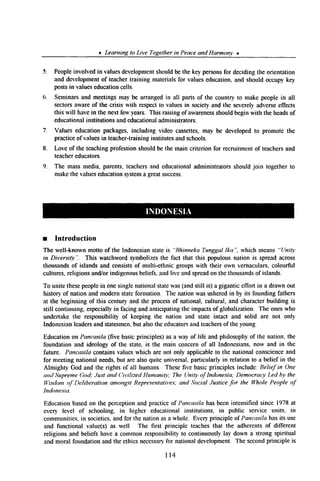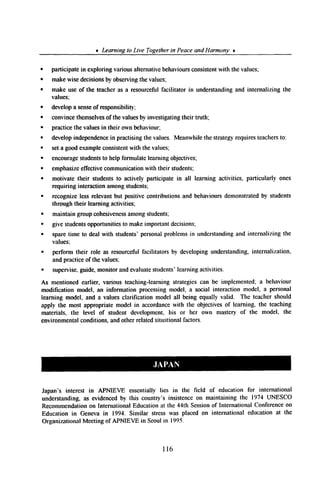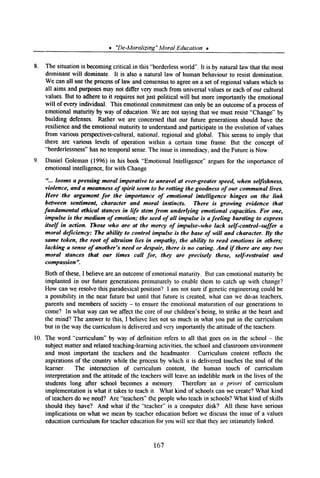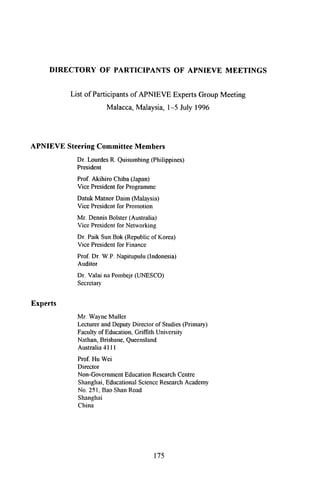This document provides an introduction and overview of a sourcebook on values education for peace, human rights, democracy and sustainable development in the Asia-Pacific region. It was produced by APNIEVE (Asia-Pacific Network for International Education and Values Education), in collaboration with UNESCO. The sourcebook contains chapters on the APNIEVE philosophy, regional context, education for living together, teaching guidelines and sample lesson plans, the state of values education in teacher education programs, and related declarations. It aims to equip students and teachers with the knowledge, skills and attitudes needed to live together in peace and harmony through international education and values education.









![t TheAPNIEVE Philosophy *
distributedand usedin educationalestablishments,especiallyin countrieswhere the
production of teaching materials is proving slow owing to economic difficulties.
Distance education technologiesand all modem communication tools must be
placedat the serviceof educationfor peace,humanrights and democracy.
Teacher training
23. The training of personnelat all levelsof the educationsystem- teachers,planners,
managers,teachereducators- hasto includeeducationfor peace,human rights and
democracy. This pre-service and in-service training and retraining should
introduce and apply in situ methodologies,observingexperimentsand evaluating
their results. In order to perform their tasks successfully,schools,institutions of
teachereducationand thosein chargeof non-formal educationprogrammesshould
seekthe assistanceof peoplewith experiencein the fields of peace,human rights
and democracy(politicians,jurists, sociologistsand psychologists)and of the NGOs
[non-governmentorganizations] specializedin human rights. Similarly, pedagogy
and the actual practiceof exchangesshouldform part of the training coursesof ail
educators.
........................................................................................................................................................................................................
Thus. APNJEW’s programmeof activities will include:
+ the sharing and exchange of information on the current situation in the participants’
countries with regard to the development of policies and programmes, and the
implementationof internationaleducationandvalueseducationat the teacher-training level;
+ workshops to review existing curriculum models, modules, or materials, and to design
prototype models,modulesor materialsfor adaptationand use in Member Statesas well as
for pre-testing and evaluation purposes.Efforts to work with other regions involved in
programmesand projectson peace,tolerance,non-violence,human rights, democracyand
international understandingwill be pursued.
To carry out the aboveactivities, APNJEW holds yearly conferencesand workshopswith the
supportof JJNJZSCOand underthe guidanceof a SteeringCommitteefrom sevenMember States,
and with UNJXSCOPROAPasSecretariat.
APNJEVJZ’svision of the future is inspired by the report of the International Commission on
Education for the Twenty-first Century, chaired by JacquesDelors, which emphasizesthe need
for each individual to learn how to learn, and requiring a better understandingof other people
and the world at large, peacehI interchangeand harmony, which are sadly Jackingin our world
today. Of the four pillars of education, “learning to live together” is the one most vital to
building a genuineand lasting culture of peacein both the Asia-Pacific region and throughout the
world. The three other pillars - “learning to know” “learning to do”, and “earning to be” - are,
the basesfor learning to live together.
APNJEVE’s definition of “learning to live together”,and the valuesrequiredfor it from the Asia-
Pacific perspective,was arrived at by expertsfrom nine countrieswho met in Malacca, J-4 July
1996. to reflect on and sllare their views as to what “learning to Jivetogether”meansand what
valuesare requiredto achieveit. particularly in the Asia-Pacificcontext.
3
~ .-
1 n](https://image.slidesharecdn.com/learningtolive-150128004542-conversion-gate02/85/Learning-to-live-10-320.jpg)






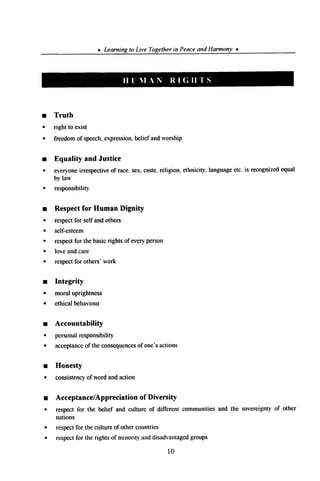



















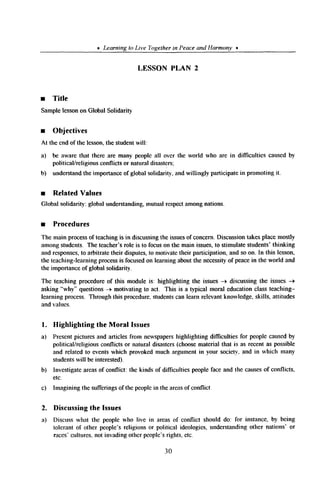















![Figure4. Map of theAsia-PacificRegion APEC LINGO
* Xustralia initiated the creation
of a free-market area m the
region to be a part of the
dynamic growth of East
Asian economies in 1989.
Fromthisconceptsprangthe Russia
. The first gathering of 18
leaders of Apec members -.,.,,
was held in Seattlein 1993. Kazakstan ,a
Indonesia became the next ., _. Mongolia
hostthe following year,when
tiibekistan
all agreedto opentheirtradeby i”rke;^ :
T”*;e~,str” $!mstan
- -
‘Tajikistm
Korea,
. DPR,
2010 for developedeconomies iran Afghan& I^-. China -’ ,, *
Korea,
JEpZlll
and 2020 for still-developing Pakistan Nepa’ Rep. d
ones. Ehtin
z
B.ngl;desh
l In Osaka in November, leaders India ~~~~~~~LAOS
submitted parts of their plans for
Thail&d Wet NWV Marshall Islands
Cpmbodla
freeingandopeningtheir trademarkets Sri Lanka , ._
_ : Philippines
,,J .;:
_c...-.
andinvestments,facilitating businessand MLysi*
NlUN
cooperatingat the economicand technical
Maldives ;_ % 1
Papua *.
-. .-_, New Guinea
Ind:qncsi+~ :-,,,a,.- ‘.,a ‘t., Kiribati
levels. _~.
)>..=^’2
.-;i”jb, Solomon
. ^,.“% ‘, p -: ; ,. .? Islands
” -’ *?
..%_ ._ .a Tuvaki
* In four months,the 18leadersofApec will present vanautuSamoa Cook Islands
.. .I
in Subicall their plansforApec on 15specifictrade
: ;
, Niue
areas: tariffs, nontariffs, services, investment, Australia _
Fiji
Tonga
standards and conformance customs procedures.
intellectualpropeity rights,competitionpolicy, government - 5
procurement,deregulation,rules of origin, disputemediation.
_.
mobility of businesspeople,implementationof theUruguayRound
andinformationgatheringandanalysis. New Zealand
n Also in Subic, plans will be spelledout by working and experts’groups
focusing on the following I3 economic and technical cooperation:human
resourcesdevelopment,industrial scienceand technology,small and medium
enterprises,economicinfrastructure,ener_q,transportation,telecommunicationsand
information, tourism, trade and investment data, trade promotion, marine resources
conservation,fisheriesandagri-culturaltechnology.
ONE of Apec’s guiding
principles, open regionalism
was defined by the Eminent
Persons Group as: a processof
regional cooperation whose
outcomeis not only the actual
reduction of internal [intra-
regional] barriers to economic
interactionbut also the actual
reduction of external barriers
to economiesnot part of the
regionalenterprise.
In 1994, Apec members
envisioned themselves to be the
opposite of the European
Union, which they claimed as
inward-looking or running a
customs union exclusively
among the Europeanmembers.
Under open regionalism, any
individual Apec member can
extend its Apec liberalization
toward free trade to non-
membersona conditionalbasis
[via free-tradearrange-ments]
or onanunconditionalbasis[to
all nonmembers, or to all
developing countries, in
conformity with GATT rules].
(Source:SelectedApec Documents
1989-1994)](https://image.slidesharecdn.com/learningtolive-150128004542-conversion-gate02/85/Learning-to-live-53-320.jpg)















































![* Learning to Live lbgether in Peaceand Harmony *
Statement 2.
Australian International Development AssistanceBureau (1989) Development Dictionary: A
Glossary ofAid and DevelopmentTerms.AGPS, Canberra.[AIDAB is an official government
aid agency,which is part of the Departmentof Foreign Affairs and Trade. It is responsiblefor
administering Australia’s overseasaid programme.]
Statement 3.
Ian Lowe (I 990) Sustainabledevelopment:How do we get there?,Australian Society, June, No.
5. [AssociateProf. Ian Lowe is the Director of the SciencePolicy ResearchCentreattachedto the
Division of Science and Technology at Griffith University and is a former Director of the
Commissionfor the Future.]
Statement 4.
World Commission on Environment and Development(1987) Our Common Future, Oxford
University Press,Oxford. [The WCED was an independentinternational body consisting of
twenty-three commissioners,including prominent political figures and leaders in environment
and development.]
Statement 5.
Robert Repetto (1986) World Enough and Time, Yale University Press, New Haven. [An
economist1
Statement 6.
Robert Goodland and G. Ledoc (1987) Neoclassicaleconomicsand principles of sustainable
development,EcokogicalModelling, 38. [At the time of writing, Goodlandand Ledocworked for
Environmental and Scientific Affairs, Projects Policy Department, World Bank, Washington.
DC.1
Statement 7.
RobertAllen (1980) How to SmJethe World,KoganPage,London, p. 23
Statement 8.
JamesCoomer(1979) The natureof the questfor a sustainablesociety,in J. Coomer,ed.. Quest
,fiw a SustainableSocie@,PergamonPress,Oxford.
Statement 9.
Prime Minister Margaret Thatcher.Speechto the RoyalSociety,UK, 27 September1988
94
I--- ~____ r---](https://image.slidesharecdn.com/learningtolive-150128004542-conversion-gate02/85/Learning-to-live-101-320.jpg)
![* LessonPIanson SustainableDevelopment *
Statement 10.
The Commission for the Future (1990) A sustainablefuture for Australia, in Our Common
Future, Australian Edition, edited by StephenDovers, p. 25. [The Commission for the Future
was establishedby the CommonwealthGovernmentto encourageAustralians to becomeinvolved
in the economic and social opportunities made possible by scientific and technological
development. Its function is to explain the socialimpactsof scienceand technologyand to foster
the developmentof an innovative,productiveculture.]
Statement 11.
Canadian University ServicesOverseas,Here to Stay: A Resource Kit on Environmentally
SustainableDevelopment(publication date unknown). [CUSO is an international development
agency based in Canada. The organization works to promote understanding and action on
international developmentissuesand to foster relationshipsof support between Canadian and
overseasgroupsworking for socialchange.]
Statement 12.
John Woodley (1990) Summary of the Australian DemocratsPolicy Statement,in Queensland
Action for World DevelopmentNewsletter, No. 3, May. [John Woodley is a Uniting Church
Minister and Senatorfor the Australian Democratsin the Australian Parliament.]
Statement 13.
Barry Rowe(I 990) Minister for Agriculture and Rural Affairs, AAP newsbulletin, 6 September.
Statement 14.
Australian Commonwealth Government (1990) Ecologically Sustainable Development: A
( ‘onrnronwealthDiscussionPaper, June.
Statement 15.
Gordon Conway and Edward Barbier (1988) After the Green Revolution: Sustainable and
equitable agricultural development,Futures, 20 (6) p. 653. [At the time of writing Gordon
Conway was the Director and Edward Bat-bier the Associate Director of the Sustainable
Agricultural Programmeat the International Institute for Environment and Developmentattached
to the London EnvironmentalEconomicsCentre].
Statement 16.
Australian ConservationFoundation,Greenpeace(Australia), The WildernessSocietyand World
,WideFundfor Nature(1990)Ecologica@ SustainableDevelopment,ACF, Fitzroy.
95](https://image.slidesharecdn.com/learningtolive-150128004542-conversion-gate02/85/Learning-to-live-102-320.jpg)


















